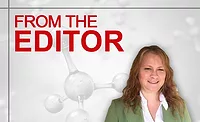M&A Corner
COVID-19: The Black Swan
Though the COVID-19 pandemic caused a major slowdown in merger and acquisition activity, strategic and "bolt-on" deals are still getting done.

As we headed in to 2020, merger and acquisition (M&A) activity in chemicals and materials was humming along at near-historical levels. High valuations did not seem to deter buyers, with private equity (PE) firms clamoring to place capital and strategic buyers motivated for acquisitions to bolster their growth and help justify their high stock prices. Deal making was in full swing, and it truly was a “seller’s” market. Everyone expected 2020 to be another banner year for M&A.
The emergence of COVID-19 in early 2020 was a “black swan” event that virtually no one could have predicted, and the pandemic that followed (and continues at the time of this writing) will undoubtedly alter the course of history. As COVID-19 began sweeping across the U.S. and the world, major chemical companies quickly placed priority on maintaining employee health and safety and on ensuring operational continuity.
Almost overnight, many companies faced supply chain disruptions and experienced a decline in demand for their products. The impact was particularly felt by companies operating in more cyclical markets like automotive, aerospace, and durable goods. Not surprisingly, many M&A projects were put on hold, as executives and business owners focused their resources internally and lending markets shuttered.
Focusing on Specific Targets
However, M&A did not stop completely. In the months since the pandemic began, we have seen a number of closed deals as evidence of transaction processes that continued during the initial depths of the pandemic (and we can attest to this, as Grace Matthews advised on four transactions that closed during the tumultuous second quarter). The common theme we’ve seen in many of the M&A deals announced in recent months is a strong, strategic fit between the acquirer and the target. Our sense is that while many strategic buyers remain “open” for M&A, they are acutely focusing their time on highly strategic targets and avoiding those that may only have a tangential fit. These strategic deals are generally the ones getting done.
Another theme we’re seeing is a skew toward smaller, “bolt-on” acquisitions that generally carry lower risk for the buyer. One recent example is Arkema’s acquisition of Fixatti, which was announced in early July. Fixatti is a Europe-based producer of high-performance thermobonding adhesive powders. In a press release, Arkema described the deal as part of its strategy “to complement the organic growth of its Adhesive Solutions segment with high-quality bolt-on acquisitions.” Arkema’s comments are representative of the mindset among many large chemical companies today.
In our view, companies that emphasize M&A efforts now are likely to emerge from the pandemic far better positioned than those that do not. As such, these bolt-on acquisitions are likely to continue despite the turmoil caused by the pandemic. In all of this, the good news for sellers is that most strategic buyers still have relatively healthy balance sheets and capital available to pay full, fair values for companies that offer a good strategic fit.
Increasing Carve-Out Activity
As companies continue to manage through this challenging environment and try to understand what the “new normal” might look like, we expect to see internal resources funneled to their highest-priority businesses. As has been the case for the last few years, non-core businesses will be identified as such internally, and many may ultimately be considered as divestiture candidates. Carve-out M&A activity will likely see an increase as we head through the rest of the year and into 2021.
We’ve already seen signs of this, with Henkel announcing the divestiture of its thermal clad dielectric material business (a non-core part of its 2014 acquisition of Bergquist) and Dow selling its North American rail infrastructure assets (proceeds being used to pay down debt and “invest in core value-generating businesses”). We also expect to see PE groups, which raised record amounts of capital in recent years (and are in the business of doing deals), come back to the negotiating table as the economic and lending environments begin to reopen. That said, bolt-on acquisitions for PE-owned platform companies will likely remain a priority over new platform investments, at least in the near term.
Future Outlook
While the COVID-19 pandemic will keep some buyers and sellers on the sidelines for the time being, the underlying factors supporting M&A over the last few years—capital availability, aging owners of private companies, and the need for the large public companies to show growth—are still present and are as relevant as ever. M&A has been important to the evolution of the adhesives and sealants market (and broader chemicals industry) for many years, and we’re seeing those green shoots of activity start to emerge. We expect they will only get stronger from here.
Looking for a reprint of this article?
From high-res PDFs to custom plaques, order your copy today!





